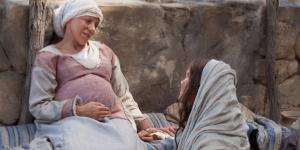You are here
How Does the Parable of the Willing and Unwilling Sons Teach about Christ?

Matthew 21:28–29
The Know
The day after Jesus cleansed the temple, the chief priests and elders came to Him and demanded to know why He performed such an action, asking, “By what authority doest thou these things? and who gave thee this authority?” (Matthew 21:23). In response, Jesus posed a question—where John the Baptist received his authority to baptize—which the priests and elders could not answer. Jesus responded, “Neither tell I you by what authority I do these things” (Matthew 21:27).
Jesus then offered numerous parables, beginning with the parable of the willing and the unwilling sons. While Jesus’s move to teaching with parables in this instance may seem out of place, John and Jeannie Welch have observed that the parable of the willing and unwilling sons is quite pertinent to the context. While Jesus would not expound on His authority in any explicit terms, He would “answer both of their two calculating questions.”1 Only those who were spiritually attuned would then be able to discern His answer.
Ultimately, this “parable embraces three elements of the plan of salvation: (1) that the plan was set forth by the Father in the premortal council in heaven, (2) that Jesus was selected by the Father in the premortal council in heaven, and (3) that the Father had conferred upon Jesus the all-important authority to act in the Father’s name according to His will.”2 This is especially evident when one examines the underlying Greek text.
When the father approaches his first son, the King James Version records the interaction thus: “Son, go work to day in my vineyard. He answered and said, I will not: but afterward he repented, and went” (Matthew 21:28–29). This translation is ambiguous “partly because the Greek itself is purposefully ambiguous,” and modern English readers might understand that the son appears to be “utterly refusing to go.”3 However, the Greek text does not imply this; rather, it “should be translated more like it is not (ou) my will or my wish (thelō) to go.”4
When understood in this context, it becomes clearer how this first son might typify Christ. Throughout His mortal ministry, Jesus often said that He came to do not His own will but rather the will of the Father: “For I came down from heaven, not to do mine own will, but the will of him that sent me.”5 Even in Gethsemane, as Jesus suffered for the sins of the world, His prayer was to reconcile His will with the Father’s: “O my Father, if it be possible, let this cup pass from me: nevertheless not as I will, but as thou wilt.”6
Similarly, the first son in this parable reconciled himself to the will of his father and went to the vineyard. John and Jeannie Welch note that the King James rendering as “repented” is unfortunate, as the Greek employs a word with only a similar meaning “but not the same meaning.”7 Understanding the son as reconciling his will with his father’s allows us to understand more deeply how Jesus suffered willingly for us.
The second son in this parable likewise desired to go into the vineyard but for drastically different reasons. While the King James Version says that this son enthusiastically states, “I go,” the Greek text simply reads “I” (Matthew 21:30).8 Yet, this son did not do the will of the father. John and Jeannie Welch note the similarities between this parable with accounts of the premortal Council in Heaven found in Moses and Abraham.
In Moses 4:1, Lucifer is recorded as giving a very similar response to the Father as this second son gives to his. Lucifer’s response focuses inordinately on the man himself, seeking to draw the attention of those present: “Behold, here am I, send me, I will be thy son, and I will redeem all mankind, that one soul shall not be lost, and surely I will do it; wherefore give me thine honor.” Such a lofty response stands in stark contrast to the answer of Jesus Christ: “Father, thy will be done, and the glory be thine forever” (Moses 4:1–2, emphasis added; cf. Abraham 3:27).
Thus, this parable offers a direct declaration that Jesus Christ is the first son, who went to do the will of His Father as He agreed to in the premortal council. Such a declaration would not have been lost on His audience, either. John and Jeannie Welch note that “the chief priests knew enough about heavenly councils from their own Hebrew prophetic traditions—as well as from Jesus’s open statements at the temple about coming to do the will of the Father who had sent Him (see John 5:30)—that they would well have understood what Jesus was talking about.”9
The Why
Jesus Christ is our perfect exemplar. From the very beginning, He recognized the Father’s will and sought to do all that was needed of Him. As we seek to follow Jesus’s example, then, we can learn how we are to continually reconcile our will with God’s by repenting of our sins and seeking the presence of the Holy Ghost in our lives.
We can similarly see this parable as an invitation to follow Jesus’s example. As Jesus Himself taught, when the publicans and harlots heard John the Baptist preach in the wilderness, they believed in his words and repented of their sins. In other words, they reconciled their will with the Father’s will, allowing their desires to be swallowed up in His. Because of this, Christ assured them that they would have a place in the Father’s kingdom (see Matthew 21:31–32).
That promised blessing of peace and enjoyment of the Father’s kingdom is similarly open to all who repent and follow Jesus Christ as His disciples. It is never too late, no matter where we are on life’s path, to leave our worldly desires behind us and follow Him. As we do so, we can have the same mentality that Jesus had and similarly promise the Lord, “Father, thy will be done, and the glory be thine forever” (Moses 4:2).
Further Reading
John W. Welch and Jeannie S. Welch, The Parables of Jesus: Revealing the Plan of Salvation (American Fork, UT: Covenant Communications, 2019), 44–49.
John W. Welch, “Symbolism in the Parable of the Willing and Unwilling Two Sons in Matthew 21,” in Let Us Reason Together: Essays in Honor of the Life’s Work of Robert L. Millet, ed. J. Spencer Fluhman and Brent L. Top (Provo, UT: Religious Studies Center, Brigham Young University; Salt Lake City, UT: Deseret Book, 2016), 97–116.
- 1. John W. Welch and Jeannie S. Welch, The Parables of Jesus: Revealing the Plan of Salvation (American Fork, UT: Covenant Communications, 2019), 45.
- 2. Welch and Welch, Parables of Jesus, 44.
- 3. Welch and Welch, Parables of Jesus, 45.
- 4. Welch and Welch, Parables of Jesus, 45.
- 5. John 6:38; cf. John 4:34; 5:30.
- 6. Matthew 26:39; cf. Mark 14:36; Luke 22:42.
- 7. Welch and Welch, Parables of Jesus, 46.
- 8. See Welch and Welch, Parables of Jesus, 46.
- 9. Welch and Welch, Parables of Jesus, 46.
KnoWhy Citation
Related KnoWhys
Subscribe
Get the latest updates on Book of Mormon topics and research for free





